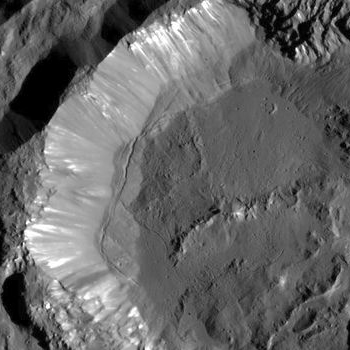A river on Mars

Cool image time! The science team for the high resolution camera on Mars Reconnaissance Orbiter this week released it monthly set of cool images. One of those images, which I have cropped and reduced to show it here, is of an ancient river on Mars, the formation process of which geologists still debate. As the scientists note,
The channel pattern, called “dendritic” because of its tree–like branching, begins at the top of the image and runs down over the rim of an ancient impact basin across the basin floor. The soil surface overlying these channels, and indeed the entire landscape, has been changed and reworked over the intervening millions of years, by the combined actions of wind and ice. Over time, the original channels become muted or even erased.
One thing I learned in writing an article for Astronomy about the rivers seen on Saturn’s moon Titan is that without plant life there is no known natural process to hold river banks in place. Instead, if the grade is shallow and not confined by bedrock cliffs, rivers will meander about randomly forming braided channels as there will be nothing on shore to hold the water within the same course. For example, on a lifeless Earth the water draining the central basin of the midwest United States would have flowed south across a wide scattered area covering the entire plains, rather than flowing within the courses of the Missouri and Mississippi rivers.
Thus, it is not surprising that this river on Mars appears muted or partly erased. It probably was never very clearly delineated in the first place.

Cool image time! The science team for the high resolution camera on Mars Reconnaissance Orbiter this week released it monthly set of cool images. One of those images, which I have cropped and reduced to show it here, is of an ancient river on Mars, the formation process of which geologists still debate. As the scientists note,
The channel pattern, called “dendritic” because of its tree–like branching, begins at the top of the image and runs down over the rim of an ancient impact basin across the basin floor. The soil surface overlying these channels, and indeed the entire landscape, has been changed and reworked over the intervening millions of years, by the combined actions of wind and ice. Over time, the original channels become muted or even erased.
One thing I learned in writing an article for Astronomy about the rivers seen on Saturn’s moon Titan is that without plant life there is no known natural process to hold river banks in place. Instead, if the grade is shallow and not confined by bedrock cliffs, rivers will meander about randomly forming braided channels as there will be nothing on shore to hold the water within the same course. For example, on a lifeless Earth the water draining the central basin of the midwest United States would have flowed south across a wide scattered area covering the entire plains, rather than flowing within the courses of the Missouri and Mississippi rivers.
Thus, it is not surprising that this river on Mars appears muted or partly erased. It probably was never very clearly delineated in the first place.



